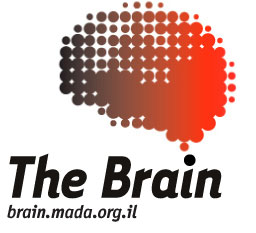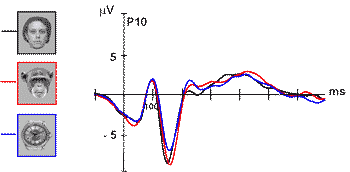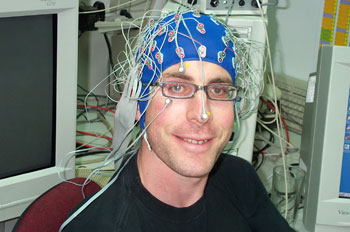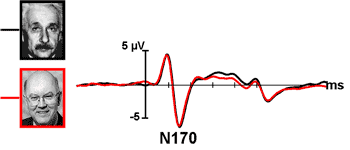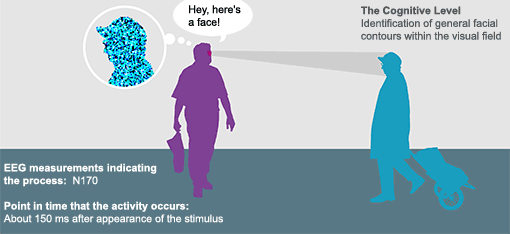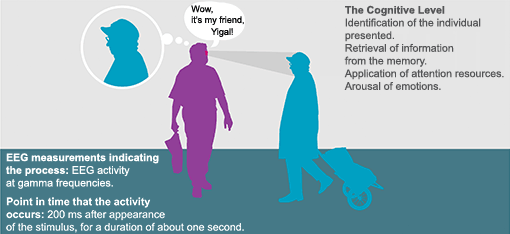


 |
||||
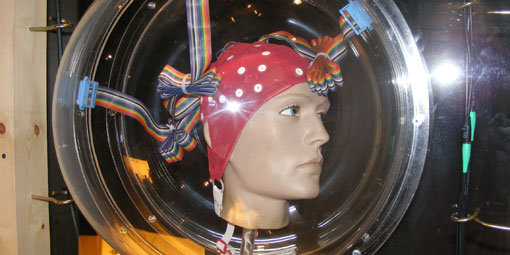 |
||||
Research team: The Research Question In this research, we wanted to examine the neural mechanisms behind our special ability to identify faces. The Research Tool To do that, we used a method for measuring electrical activity in the brain - electroencephalography, or EEG for short. Electrodes attached to the head of the subject detect the electrical field produced by tens of thousands of neurons in the brain's cortex. The highly complex electrical signal recorded by EEG provides us with data about different types of brain activities. This experiment focused on two measurements of brain activity: 1. The N170 Component
Conclusion A: The N170 indicates brain activity related to the processing of faces. Conclusion B: Although the N170 is associated specifically with faces, it does not explain our special ability to identify faces (since we're not very good at identifying different monkeys' faces). 2. Activity in a High Frequency range called the "Gamma Band" Since face identification is a complicated process that requires cooperation between our visual processing system and the retrieval of information from our memory, we hypothesized that gamma activity may be involved in this process. The Experiment
The Results of the Experiment
Gamma frequency activity in response to familiar faces and unfamiliar faces
Discussion and Conclusions While the N170 is a specific response to faces (as opposed to objects), we saw that it is not sensitive to the identity of the face. (That is, the N170 does not differentiate between familiar and unfamiliar faces.) We suggest, therefore, that this response indicates identification of the overall form of the face, with no additional information. This idea is consistent with the finding that the N170 is similar for responses to human faces and monkeys' faces. Unlike N170, gamma activity is affected by face identification, and it is higher for familiar faces than for unfamiliar faces. How can we interpret this finding? One possibility is that gamma activity reflects the retrieval of information from our memory, which helps us identify the face we see. Another possibility is that heightened gamma activity indicates that greater attention resources are being used to process familiar faces, or that secondary mechanisms (such as personal memories about the individual or emotional responses) are being activated when a face is identified - mechanisms that are irrelevant for unfamiliar faces. It is important to note that while the N170 response begins and ends in a brief instant, the gamma response lasts for more than a second after the stimulus appears - a very long time in terms of the brain, perhaps indicating that gamma activity reflects several processes rather than only one. The Proposed Model for Face Identification
The Importance of the Research and Plans for the Future The research we presented here was the first in a series of experiments we conducted to explore the neural mechanisms involved in learning new faces, learning details about individuals, and retrieving what we've learned from our memory when the need arises. We also began examining what occurs in the brain when we misidentify a face or fail to recognize a face that should be familiar to us. The subject of this research is close to the heart of anyone who has experienced the frustration of not recognizing the face of a person who should be easily identified. We hope that by shedding light on the brain mechanism responsible for this important and special ability, we will better understand the process and, perhaps, help to develop methods for improving the "face memories" of healthy people and people with impaired memories or visual identification problems. More about... To raise new questions, new possibilities, The Research Question - At the root of all research is a question. Contained within this question is the scientific curiosity that led the researchers to conduct the particular experiment they did. The scientific process will continue as long as we keep asking new questions. Each question leads to a new experiment and yields results that supplement and expand the existing body of scientific knowledge. The research question not only describes the subject of the research; it plays a central role in all its stages. The researchers need to formulate a focused and precise research question, one that allows them to design an empirical experiment that can answer it. In other words, the question must be testable. Usually, researchers can make predictions about the research question based on scientific theory. Nevertheless, they must state the question as objectively as possible in order to allow for answers they did not necessarily expect. The research question is also crucial for understanding the results of the experiment and their significance - these will be scrutinized in light of the original question asked.
|
||||
